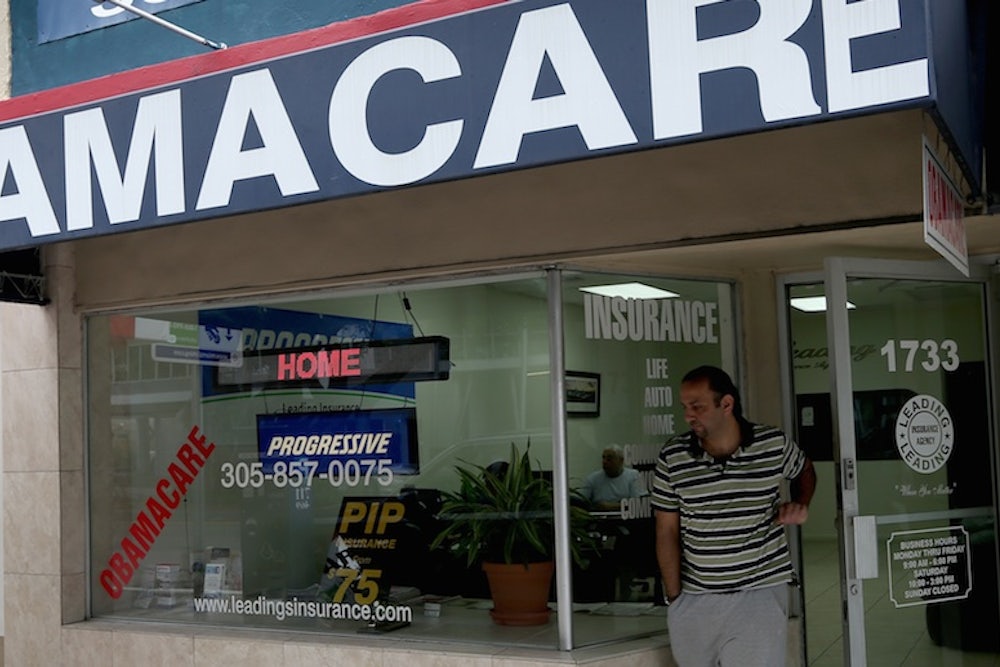Back in the spring, some conservatives insisted that Obamacare enrollment statistics were some kind of sham. Sure, people were finally signing up for the program. But early reports suggested that most of these people had insurance already. The law's critics figured that meant the Affordable Care Act wasn't really helping substantially more Americans to get coverage, as it is supposed to do.
A new report suggests that the critics were wrong about that.
It’s a survey from the Commonwealth Fund, a foundation that focuses on health care programs in the U.S. and abroad. The results provide a detailed look at the Affordable Care Act’s impact, including the question of whether more people now have insurance—and, if so, how many. The answer is consistent with previous reports. And it is encouraging.
According to the survey, the proportion of working-aged adults without insurance dropped from 20 percent in the late summer of 2013 to 15 percent in the late spring of 2014, a period that corresponds roughly to the beginning and end of open enrollment in the Affordable Care Act’s marketplaces. To put that in more concrete terms, there are still a lot of Americans walking around without health insurance today. But there are about 9.5 million fewer of them than there were last fall, almost certainly because so many people have enrolled in the newly expanded Medicaid program or purchased subsidized insurance through the Obamacare marketplaces.

How does that compare to expectations? The Congressional Budget Office predicted that, one year into full implementation, Obamacare would reduce the number of Americans without insurance by twelve million. That included the young adults who got insurance before 2014, by signing onto their parents’ plans. There’s been some controversy over exactly how many more young people are insured because of that new option, but the best estimates I’ve seen place the number somewhere between 1 and 2.5 million. Add that number to the 9.5 million from the Commonwealth survey, and you're close or equal to the CBO projections.
Of course, the Commonwealth survey has a hefty margin of error and the CBO projections, revised to take account of the early technological problems on Obamacare websites, were never that scientific. But the figures seem to be in the same ballpark. That's what matters.
The Commonwealth report includes some other interesting findings. Some rely on highly subjective judgements, without historical data to hold up for comparison, so it's difficult to know how much they reveal. Among the highlights:
- The biggest gains in coverage were among low-income groups and young people, even though the law’s critics warned (and plenty of the law’s defenders feared) that young people would be reluctant to pay for insurance, even if it meant risking a financial penalty.
- The majority of people in the survey (58 percent) thought they were better off, a minority (27 percent) thought they were basically the same as they were before, and only a small minority (6 percent total) thought they were worse off.
- Among the 21 percent who tried to find new doctors, 39 percent said they found it “very easy” and 36 percent said they found it “somewhat easy,” with the rest—about a quarter of the total—saying they found it difficult or even impossible to find a physician.
The survey's large margin of error isn't the only caveat to keep in mind. Impact on the uninsured is just one way to measure the law's performance. It's a complex reform package, full of pluses and minuses, as well as winners and losers. The ultimate question is whether the good stuff outweighs the bad stuff. It's going to be a while before we have enough data to answer that definitively. Even then, people will disagree because they have different values and priorities.
But the numbers still mater. And when you put the Commonwealth Fund findings alongside other reports—from Gallup, the Rand Corporation, the Urban Institute, and the Kaiser Family Foundation—a clear pattern emerges. Many more people have health insurance and, as a result, many more people can pay their medical bills. "This is yet another datapoint showing that the Affordable Care Act is basically doing what it's supposed to do," says Larry Levitt, senior vice president at the Kaiser Foundation. "That doesn't mean everyone is benefiting from it or is happy about it. But, it's on track to working as intended."
